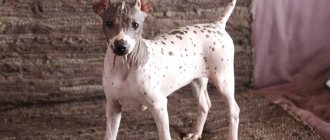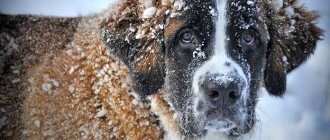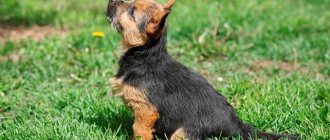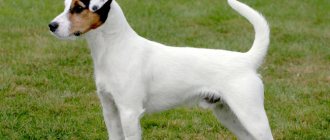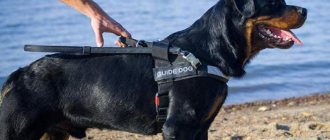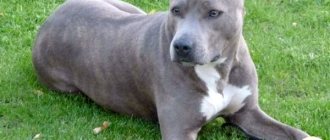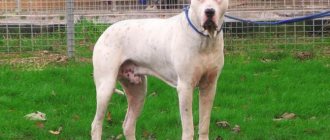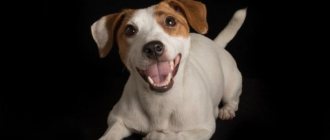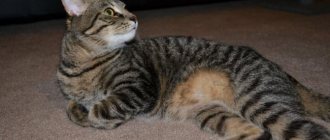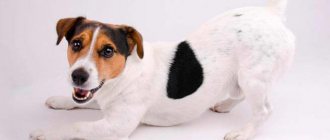Breed standard and description
A characteristic detail of the Dandie Dinmont Terrier is a fluffy “cap” of thin and delicate hairs on the head.
Height at withers: 20-28 cm Weight: 8-11 kg. Less weight is preferable.
- Color: mustard and pepper.
- Mustard varies from brown to light fawn. The coat of a dog of this color is cream. The limbs are darker than the head.
- The pepper color starts out black and ends in a light gray tint. The cap is silver, the limbs are red or fawn.
- The eyes are dark hazel, intelligent and calm. The white is not visible, the iris completely fills the orbits.
- Nose is black.
- The body is long, with short strong legs, reminiscent of a fox.
Disqualifying signs:
- Plain wool.
- No thick wool cap.
- Underdeveloped muscles of the upper jaw.
- Erect ears.
- The hind limbs are shorter than the forelimbs.
- Short body with weak muscles.
Appearance
The Dinmont Dandie is very different from other dogs in the terrier family. It has an elongated body, short legs and a fairly large head with a cap of silky wool characteristic of the breed. The weight of dogs in working condition is 8-11 kg. A minimum value is encouraged.
The head is large, but consistent with the size of the dog. The muscles are well developed, especially the upper jaw. The skull is wide, gradually narrowing towards the eyes. The forehead is convex. The entire head is covered with very soft hair. The ratio of the length of the muzzle to the length of the skull is 3:5. In the upper parts of the muzzle, the triangular area is devoid of hair. The top of the area is directed towards the eyes, and the base is approximately 2.5 cm wide at the nose. The jaws are strong and have a scissor bite. The teeth are very well developed, the canines seem large for such a small dog. The eyes are hazel-colored, set low and wide, large, round, the whites should not be visible. The ears are set close to the back of the head, low, hanging. Due to the cartilage, they lag slightly behind the head at the base. The color of the fur on the ears should be darker than the main color, but in harmony with it. The decorative fur on the ears is formed by the age of two.
The neck is well developed, very muscular and strong. The body is flexible, long, strong. Topline with a noticeable curve: low at the level of the shoulder blades, then rises to form an arch and falls to the base of the tail. The highest point is where the back meets the lower back. The chest is dropped between the front legs and is well developed. The ribs are arched. The tail is short and rather thick. When calm, it is carried cheerfully, just above the line of the back; when excited, it is almost vertical. The limbs are short with well-developed muscles and bones, widely spaced, straight and parallel. The hind legs are slightly longer than the front legs, with good angulation. The feet are rounded with black claws and strong pads, the hind feet are slightly smaller than the front ones.
The Dandie Dinmont is the only terrier whose exterior does not have a single straight line, which is, in principle, not typical for this family.
The coat is an important feature of the breed; it is double coated with a soft undercoat and a stiffer outer coat, but is not wiry. The fur on the back lies in strands and passes through the soft undercoat. The legs have feathers about 5 cm long. The upper part of the tail is covered with hard hair, the lower part is softer, which forms a dewlap. The muzzle is entirely covered with soft hair, the longer one in the upper part forms a cap. The feathering on the ears should also be well developed.
Colors:
- Pepper - from dark black to light silver. Preference is given to intermediate shades. In the lower part of the body and on the legs, the color varies from intense red to fawn. The cap on the head is pale silver.
- Mustard - pale cream cap. The body is reddish-brown to fawn. The limbs and paws are darker in color than the head.
For any of the colors, the feathering should be lighter than the fur on the front surface of the legs. Small white spots on toes and chest are allowed. The fur on the lower part of the tail is lighter than on the upper part.
History of the Dandie Dinmont Terrier breed
Dandie Dinmont Terriers were bred in England and later adapted for hunting burrowing animals. These terriers preyed on small predators with expensive fur: weasels, minks, otters, foxes, even badgers and skunks. In addition, they crushed rats, clearing fields and houses of pests. Representatives of the breed are ideal for climbing burrows.
The breed received its name thanks to Walter Scott . In the novel Guy Mannering there is a hunter character nicknamed Dandy Dinmont or Diamont. He owns a group of dogs consisting of 3 females and 3 males of the same breed, which he calls the immortal six. The man assures that these terriers are capable of catching anyone who has hair growing.
Dandy Diamont had a prototype named John Davidson. This man was known as a great hunter and thanked his dogs for his success.
It is unknown what breeds gave rise to the Dandie Dinmont Terrier. Possibly the ancestors were Scottish (extinct) and Skye terriers .
Historical sketch of the breed
For the first time, information about terriers is found in the fifty-fifth year BC, when Britain just joined the Roman Empire. The Romans everywhere saw lively small dogs that hunted compact game and rodents. They were called “earthlings” - those who hunted on the ground. Terriers sneaked up unnoticed and took prey from hard-to-reach burrows. Further, brave dogs have already begun to be taken for hunting larger animals - badgers, bears. Terrier dogs were not intimidated by the size of the wild animal.
Such aggressiveness did not concern household members - the “earth dogs” found a common language with the children. Farm owners especially liked them: terriers cleared the territory of rodents, exterminated martens, weasels, and skunks.
The origin of the breed is still considered controversial. Most likely, the Dandie Dinmont is a mixture of Skye and Bedlington Terriers. The cute “hat” is owed to the latter.
The breed received public recognition in 1955. The name comes from the hero of one of Walter Scott's works. The standard dating of the English DANDIE DINMONT TERRIER falls on the tenth of March 2021.
Description of the breed:
- - recognized on a certain basis;
- — country of origin Great Britain;
- - is not subject to mandatory performance testing in accordance with the FCI breed nomenclature.
- - the size varies from twenty to twenty-eight centimeters;
- - weight from eight to eleven kilograms;
- — a couple of color options: pepper, mustard;
- - head: large, strong, corresponds to the established sizes, with a developed jaw;
- - the skull is wide, but narrows towards the eye part;
- - frontal lobe protrudes;
- — silken fur grows thickly on the head;
- - nose black;
- - scissor bite;
- — the eyes are dark hazel, set wide and low at the same time, large and not pop-eyed, the white is not noticeable;
- - the ears hang, are wide and move towards the back of the head, while falling along the cheekbone;
- — the cervical regions are well developed, there are muscles;
- - the body is agile, elongated;
- - the tail is up to twenty-five centimeters, thick, without kinks, does not collapse, scimitar configuration, tapers towards the end;
- - the front legs are muscular, short, always straight, widely spaced, paws turned outward;
- - the hind legs are well developed, slightly longer than the front legs, widely spaced;
- — the optimal color scheme for claws is black;
- - double coat, with a very soft undercoat and a harsh base (top hair);
- — adult male dogs must have a pair of descended testes.
Temperament and character
Character advantages:
- Independence. Dogs can do without human company. If a person is busy, they will chew on a toy and communicate with other animals. They don't like to be imposed on.
- Stable psyche. These dogs easily tolerate changes in environment and accept new people.
- Silence. Dandie Dinmonts bark little and do this only in critical situations.
- Affectionateness.
- Loyalty.
Minuses:
- Stubbornness. They choose the owner once and for all. It can only be one person. Dogs obey other family members if the owner is at home. If he leaves, the terriers will not respond to commands.
- Recklessness. If during a walk terriers meet an insolent or aggressive dog of the same sex, they will rush into battle. Even if the enemy is a shepherd. These dogs were trained to protect the home, and they will protect themselves and their owner until their last breath.
Description
The attractive appearance of the breed has made them attractive in the eyes of many dog lovers. Today, Dandie Dinmont Terriers are not used for hunting; they live in houses and are cared for no less than other decorative puppies. The breed description is the standard, as the breed is officially recognized:
- height at withers – about 25 cm;
- weight – 9-11 kg;
- paws are short;
- the head is slightly oblong, looks disproportionately large in relation to the body, especially the paws;
- wide black nose;
- pronounced cheekbones emphasize the strength of powerful jaws - a distinctive feature of the hunting breed;
- the eyes are large, set wide apart, usually dark brown;
- the ears are wide, long, drooping, and develop when running;
- a muscular neck emphasizes a strong physique;
- the tail is long and thick.
The coat is long and slightly curled. Standard colors of the Dandie Dinmont Terrier are mustard and pepper. Occasionally, small white spots may be located in different parts of the body, especially on the chest.
Despite its small size, this terrier breed is distinguished by its strong build, muscularity, and density. To feel the power, you can try to take something from your pet while he is holding it with his teeth.
Character
All terrier breeds have one thing in common - their representatives try to be independent and self-confident. Dog handlers say that they have a life motto: “We are a small but proud people.” However, this does not make dandy dinmonts stubborn and disobedient. If you start raising a puppy in time, you can get a faithful friend who brings only joyful moments.
The character of this type of terrier has a number of advantages:
- independence – if the owner is busy, the pet will easily find something to do and will not become boring;
- silence - you can hear barking extremely rarely, usually puppies squeak a lot when they are with their mother, and as they grow older they rarely show their voice;
- They easily adapt to a change of environment, meet new people, and accept new pets.
The main character advantage is loyalty. From childhood, a puppy understands who is the owner. Attachment develops not only to him, but also to the entire family, even if it is large. Training a Dandie Dinmont Terrier is not easy. The dog's stubbornness constantly shows up. First you need to teach the puppy to respond to its name, then learn the basic commands: come to me, you can’t, others.
Popular nicknames of dandy dinmonts are Doddy, Waldo, Zhostik, Loya, Joselle.
Man and dog
By temperament, dogs are suitable for people who are not very active or busy. They won't get bored alone, but will be happy to go for a walk.
The Dandie Dinmont Terrier is an excellent watchdog . He is not able to drive away a thief or attacker, but will warn of an incident with a loud bark.
The dog feels great in the city. Thanks to his calm nature, he will get used to cars and a lot of people.
gets along easily with children and other animals . It will tolerate the child's careless behavior and will ignore birds, cats or other pets. Just don’t have other dogs of the same sex, otherwise fights are inevitable.
Maintenance and care
Dandie Dinmont Terriers are not sensitive to temperature changes. In winter, thick wool protects them from the cold; in summer, it prevents the sun's rays from penetrating their skin.
If you live in a place where the temperature drops below -10 degrees, then you will have to get clothes. In cold weather, dress your terrier in a sweater or overalls. In hot weather, a dog fan or a special cooling mat will help.
To keep your dog's muscles toned, walk him every day. But avoid routes with steps. Going up and down stairs is bad for your back.
Dogs of this breed are unpretentious to food . They do well if they eat lean meat and vegetables. Their diet also includes milk, cottage cheese, cheese, eggs and heavily boiled rolled oats. Don't forget the vitamin and mineral supplements your veterinarian will recommend. Sometimes you can pamper your Dandie Dinmont Terrier with a raw beef bone.
An important aspect of hair care is trimming . Pinch off dead hairs with your hands and not with special scissors, otherwise the wool will deteriorate. Brush your dog regularly and take him to the groomer regularly.
Brush your terrier's teeth regularly. To do this, buy a special toothpaste and a dog toothbrush. Clean your dog's ears with cotton swabs dipped in ear cleaner or boiled water. Do this at least once a week.
Clean your eyes with special products. Nails should be trimmed as soon as they grow back. After cutting, treat the claws with a nail file.
Character and education
As they say, a soft and fluffy dinmont is only external. The plush appearance is deceiving. The dog has a fighting and fearless character, brought up by hunting and nomadic life. The brave and determined terrier is inferior to other service dogs only in size, but the superiority of the enemy is not scary for him. The terrier’s own territory and owner are inviolable, so any attack will be belligerently repelled.
In the family circle, Dandy Terriers are the complete opposite. Cheerful, energetic, playful animals will be happy to join in the fun and play with children. Dogs are sociable and get along well with other pets. But small rodents are prey for them, so terrier owners should not have hamsters and decorative rats.
Dinmont owners should never forget about the independence and some willfulness of the little leader.
From childhood, the dog must strictly follow the family hierarchy, the owner must be a leader and a well-deserved authority. Owners should not neglect the education and training of the terrier. Dinmonts are excellent watchmen and security guards. Loyalty to the owners and suspicion keep the dog always on guard of order. Dandy terriers will be excellent companions for people leading an active lifestyle. Endurance, activity, cheerful disposition and intelligence will become a real incentive for athletes and travelers. The innate intelligence of a dog greatly facilitates training and education. Terriers catch on the fly and quickly remember commands.
Similar article: Description and characteristics of all types of terriers
Education and training
The Dandie Dinmont Terrier is stubborn . Training will require a lot of patience, time and endurance.
As soon as the dog is 4-5 months old, start teaching basic commands. First of all, your pet must remember “No”.
If you are a beginner, do not try to handle the training yourself; it is better to take your pet to a dog trainer and train with other dogs in a group. This will help your pet become less aggressive towards members of its own species and gender.
Health and life expectancy
Representatives of the breed live on average 11-14 years . First of all, the Dandie Dinmont Terrier is prone to the following diseases:
- Back diseases , for example, prolapse of spinal discs. Long-format dogs are prone to back problems. If he moves awkwardly, doesn't like to run, or flinches when you touch his back, rush to the vet. To avoid problems, do not allow your dog to climb stairs or steep slopes.
- Glaucoma , causing blindness. This is a hereditary disease. Glaucoma can be treated with medications or surgery. If your dog's eyes are watery, he has trouble seeing at night, and he scratches his face, visit your veterinarian.
Vaccinations and susceptibility to disease
On average, Dandie Dinmont Terriers live about 15 years. To extend the life of your pet, you need to be vaccinated against infectious diseases and undergo annual preventive examinations with a veterinarian.
The veterinarian will be able to promptly notice and possibly stabilize the onset of the disease. Despite good health, the breed is still prone to certain diseases:
Treatment for fleas and helminths is carried out quarterly.
Breed photo
A selection of photos of Dandie Dinmont Terriers.
Add a comment Cancel reply
Pros and cons of the breed
Like any breed, Dandie Dinmont Terriers have positive and negative qualities. Owners of such dogs highlight the following advantages:
- quite original and attractive appearance,
- are in good health,
- devoted and faithful animals,
- can be kept in an apartment due to its small size,
- do not require much time for care,
- are great with children
- unpretentious in nutrition,
- no smell, clean.
However, despite the many advantages, many owners also highlight negative qualities. These include:
- the need for constant physical activity,
- love for long and loud barking,
- tendency to behave aggressively towards other dogs,
- the risk that the hunting instinct will awaken, resulting in deterioration of character,
- problems with the spine often occur,
- love for pranks and pranks.
In general, dogs are very smart and good-natured, so it is quite possible to use them as companions.
